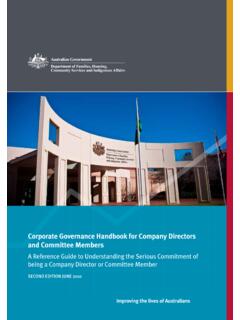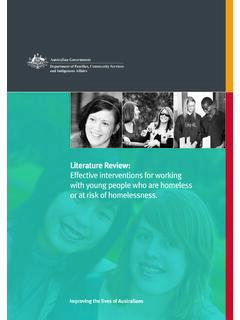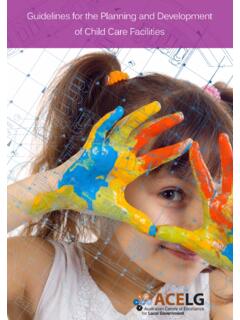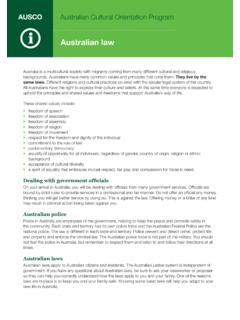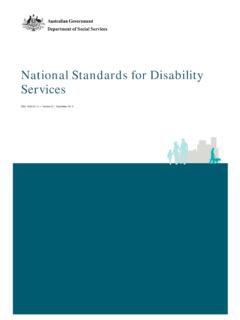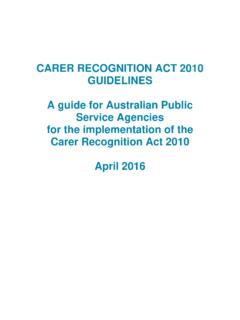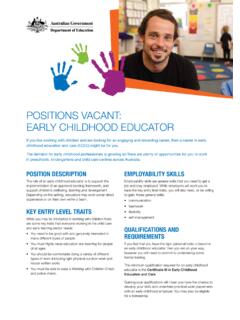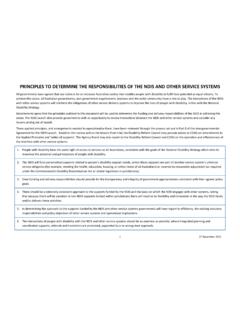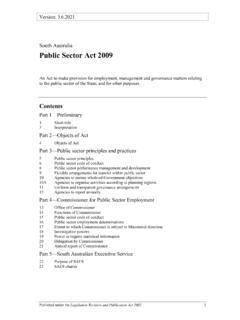Transcription of An initiative of the Council of Australian Governments - DSS
1 INational Disability Strategy 2010 2020An initiative of the Council of Australian Governments2010 2020 National Disability Strategy iiNational Disability Strategy 2010 2020tISBN 978-1-921647-39-0 Commonwealth of Australia 2011 This work is copyright. Apart from any use as permitted under the Copyright Act 1968, no part may be reproduced by any process without prior written permission from the Commonwealth available from the Commonwealth Copyright Administration, Attorney-General s Department. Requests and inquiries concerning reproduction and rights should be addressed to the Commonwealth Copyright Administration, Attorney-General s, Robert Garran Offices, National Circuit, Canberra ACT 2600 or posted at of this booklet are available to download at or If you would like a copy in easy English, Braille or audio.
2 Please phone 1800 050 009 or email TTY users phone 1800 555 677 and ask for 1800 050 document was designed and printed by an Australian Disability Disability Strategy 2010 2020tContents03 Foreword07 OverviewINTRODUCTION 12 ThE hUmAN RIGhTS ImpERATIvE 16 ThE SOCIAl ImpERATIvE 17 ThE ECONOmIC ImpERATIvE 19 ImplEmENTATION plAN 66 GOvERNANCE ARRANGEmENTS 66 STAkEhOlDER ENGAGEmENT 67mONITORING AND REpORTING 67 Notes116570 Why we need a National Disability StrategyImplementing the National Disability StrategyvISION 22pRINCIplES 22 WhO IT COvERS 23 ROlES AND RESpONSIBIlITIES 24 RESEARCh 26 AREAS Of pOlICY ACTION 2721 The National Disability Strategy Inclusive and accessible communities 29 Rights protection, justice and legislation 36 Economic security 42 Personal and community support 47 Learning and skills 53 Health and wellbeing 591234562 National Disability Strategy 2010 2020 National Disability Strategy 2010 202003 All Governments are committed to a national approach to supporting people with disability to maximise their potential and participate as equal citizens in Australian development of this National Disability Strategy is the first time in Australia s history that all Governments have committed to a unified, national approach to improving the lives of people with disability, their families and carers, and to providing leadership for a community -wide shift in attitudes.
3 This commitment recognises the need for greater collaboration and coordination by all Governments , industry and communities to address the challenges faced by people with disability. A new approach is needed to guide policies and program development by all levels of government and actions by the whole community , now and into the Strategy builds on the significant work undertaken to date by all Governments . The National Disability Agreement, signed by Commonwealth, State and Territory Governments in 2008, was an important first step towards a new, cooperative approach by Australian Governments to supporting Australians with disability. By ratifying in 2008 the United Nations Convention on the Rights of persons with Disabilities, Australia joined other countries in a global effort to promote the equal and active participation of all people with disability.
4 The National Disability Strategy will complement these and other actions, looking beyond the specialist disability sector and Australia s international obligations. It will focus our efforts towards achieving a society that is inclusive and enabling, providing equality and the opportunity for each person to fulfil their by:The hon. Julia Gillard mp, prime minister of Australia The hon. kristina keneally mp, premier of New South Wales The hon. Ted Baillieu mp, premier of victoria The hon. Anna Bligh mp, premier of Queensland The hon. Colin Barnett mlA, premier of Western Australia The hon. mike Rann mp, premier of South Australia The hon. lara Giddings mp, premier of Tasmania The hon. paul henderson mlA, Chief minister of the Northern Territory mr Jon Stanhope mlA, Chief minister of the Australian Capital Territory Councillor Genia mcCaffery, president Australian local Government AssociationForewordNational Disability Strategy 2010 202004 National Disability Strategy 2010 202005 OverviewNational Disability Strategy 2010 202008 The National Disability Strategy (the Strategy) sets out a ten year national plan for improving life for Australians with disability, their families and carers.
5 It draws on the findings of extensive consultation conducted in 2008-09 by the National people with Disabilities and Carer Council and reported in Shut Out: The Experience of People with Disabilities and their Families in Australia (2009). The report is available at : People with disabilities want to bring about a transformation of their lives. They want their human rights recognised and realised. They want the things that everyone else in the community takes for granted. They want somewhere to live, a job, better health care, a good education, a chance to enjoy the company of friends and family, to go to the footy and to go to the movies. They want the chance to participate meaningfully in the life of the community . And they are hopeful. They desire change and they want others in the community to share their vision.
6 They recognise that Governments cannot work in isolation and they want others to see the benefits of building more inclusive communities (Shut Out, 2009).1 The Commonwealth, State and Territory Governments have developed this Strategy in partnership under the auspices of the Council of Australian Governments (COAG). The Australian local Government Association has assisted in the development of the Strategy and there will be a strong role for local Governments in its implementation. The shared vision is for an inclusive Australian society that enables people with disability to fulfil their potential as equal level of government has specific roles and responsibilities across the range of policies and programs that impact on people with disability, their families and carers.
7 The Strategy does not change the nature of these roles and responsibilities, but seeks to create a more cohesive approach across all Governments . National Disability Strategy 2010 202009 The purpose of the National Disability Strategy is to: establish a high level policy framework to give coherence to, and guide government activity across mainstream and disability-specific areas of public policy drive improved performance of mainstream services in delivering outcomes for people with disability give visibility to disability issues and ensure they are included in the development and implementation of all public policy that impacts on people with disability provide national leadership toward greater inclusion of people with disability. The Strategy will be revised and updated over its ten year life span in response to reviews of progress.
8 Australia ratified the United Nations Convention on the Rights of persons with Disabilities (CRpD) in 2008. The Strategy will play an important role in protecting, promoting and fulfilling the human rights of people with disability. It will help ensure that the principles underpinning the Convention are incorporated into policies and programs affecting people with disability, their families and carers. It will contribute to Australia s reporting responsibilities under the addition to the human rights and social imperatives for action, the Strategy acknowledges the economic imperative. projected demographic change will see a progressively older Australian population and a more urgent need to maximise the potential of all Australians. for the benefit of everyone, the barriers to the contributions that can be made by people with disability, their families and carers need to be Strategy looks beyond the specialist disability support system delivered by the Commonwealth, States and Territories under the National Disability Agreement (NDA).
9 All States and Territories have individual disability strategies; however, this is the first time in Australia that a national strategy articulates long-term goals across a number of key policy areas which impact on people with disability, their families and carers. It also provides leadership for a community -wide shift in attitudes to look beyond the disability. Shut Out reported that people with disability wanted a whole-of-life approach involving coordinated and comprehensive planning between all levels of government and across all portfolios. The Strategy embodies this approach with all levels of government involved in both its development and implementation. 10 National Disability Strategy 2010 2020 The Strategy covers six policy areas: Inclusive and accessible communities the physical environment including public transport; parks, buildings and housing; digital information and communications technologies; civic life including social, sporting, recreational and cultural life.
10 Rights protection, justice and legislation statutory protections such as anti-discrimination measures, complaints mechanisms, advocacy, the electoral and justice systems. Economic security jobs, business opportunities, financial independence, adequate income support for those not able to work, and housing. Personal and community support inclusion and participation in the community , person-centred care and support provided by specialist disability services and mainstream services; informal care and support. Learning and skills early childhood education and care, schools, further education, vocational education; transitions from education to employment; life-long learning. Health and wellbeing health services, health promotion and the interaction between health and disability systems; wellbeing and enjoyment of life.
